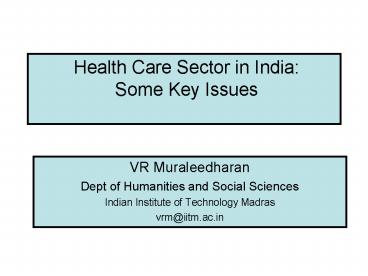Health Care Sector in India: Some Key Issues PowerPoint PPT Presentation
1 / 39
Title: Health Care Sector in India: Some Key Issues
1
Health Care Sector in India Some Key Issues
- VR Muraleedharan
- Dept of Humanities and Social Sciences
- Indian Institute of Technology Madras
- vrm_at_iitm.ac.in
2
Outline
- The Fundamental challenge in public finance
- Basic Features of Indian Health Care Sector
- Status of Health
- Access to health care (use of health care
services) - Cost of health care
- Distribution of Benefits of Public Spending
- Key Policy Questions
3
Fundamental Challenge in Public Finance
- How much should the government spend for health
care? role of government in financing and
providing health care to the people - How should the benefits of public spending (on
healthcare) should be distributed across various
socio-economic groups? Who deserves how of much
of financial support for health care? - Fundamental principle A rupee spent on one
person is a rupee denied to another person.
4
Objectives of Healthcare System
- Improve health status
- Provide protection against financial risks
arising from illnesses poverty reduction
strategy - Institute mechanisms to meet legitimate
expectations of patients
5
Health Status Indicators
6
(No Transcript)
7
(No Transcript)
8
(No Transcript)
9
(No Transcript)
10
(No Transcript)
11
Use of Health Care Services
- Dependence on Public and Private Providers
12
(No Transcript)
13
(No Transcript)
14
(No Transcript)
15
Costs of Health Care
- Financial Burden of Ill-health
16
(No Transcript)
17
(No Transcript)
18
(No Transcript)
19
(No Transcript)
20
(No Transcript)
21
Two major Health Policy Challenges
- Reduce inequity in health status
- Social and economic strata
- Reduce the impoverishing effects of catastrophic
health expenditures
22
Income inequality and health statusRecent
Evidence
- Increase in Income, Education, Health Personnel
exert a statistically significant negative impact
on health status (IMR) - But
- Increases in income inequality cause health
status (IMR) to increase. - (evidence holds good for both high income and low
income countries)
23
Utilization of Inpatient Days in Public System
TN and Orissa (NSS 60th Round 2004)
24
Utilization of Maternity Services in Public
System TN and Orissa (NSSO 60th Round, 2004)
25
(No Transcript)
26
How Much Do Governments Spend on Health
Care?AndHow much Should Government
Spend?
27
(No Transcript)
28
(No Transcript)
29
Trends in Per-Capita Public Expenditure
- Rs. 64 (1991-92)
- Rs.184 (2001-02)
- Rs.214 (2003-04)
30
(No Transcript)
31
Evidently, governments spending spent is LOW
32
Policy Options
- How should the health care system be organized?
- (Financing and Provision)
- Public vs Pvt sector
- PPP strategy?
33
PPP or PPM? Some Common Questions
- Why PPP?
- How to assess whether PPP works well?
- Conditions for PPPs success?
- What is PPP?
34
Why PPP? Some Familiar Answers
- Private sector already widely present utilize
their resources for improving public health - Better delivery system better geographical
access - Lack of funds in public sector to expand will
outsourcing reduce public expenditure? - Peoples dependence on private sector and better
satisfaction.
35
Nature of participation examples
- Financial
- Non-Philanthropic
- Joint ventures
- Subsidies and concessions to private sector
- Philanthropic Contributions
- BGF
- Local Industrialists contributions (TN)
- Drugs (from MNCs case of DEC for Filariasis)
- Non-financial
- Philanthropic
- In-kind contributions
- Community labour for construction of PHC (TN)
- Non-philanthropic
- Health Camps by corporate hospitals
36
Forms of participation examples
- Curative /Diagnostic Services
- Hiring clinical staff (OBGYN/Anesthetists/
medical officers) - Blindness Control
- Hiring nursing staff
- Contracting-out of laboratory work
- Preventive /Promotive
- Services
- HIV-AIDS role of NGOS
- TB control role of NGOs, Hospitals, Private
practitioners, Microscopy centres
37
Forms of participation examples
- Supportive services
- Ambulance
- Catering
- Security
- Laundering
- Rehabilitative
- Mental health programme?
- Reconstruction of cleft formation (BGF)
38
Policy Justifications for PPP
- PPP is not an end in itself.
- PPP should eventually
- Reduce cost of care
- Improve access to care
- Improve quality of care
- Reduce inequality in health status (geographic,
gender, socio-economic groups)
39
Thank You

